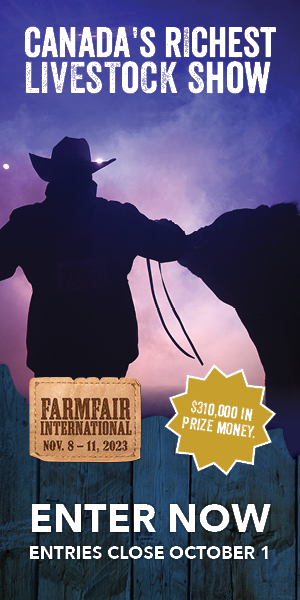AB Direct - Steers
Rail: ---
AB Direct - Heifers
Rail: ---
US Trade- Steers
Rail: 290.00 (IA)
US Trade - Heifers
Rail: 290.00 (IA)
Canadian Dollar
0.02

Three insights on controlling Canada thistle through grazing
This is the second in a two-part series on weed control in pastures. The first part, focusing on the role of rotational grazing in controlling Canada thistle, is available here.
How do you solve a problem like Canada thistle? In areas that can’t be sprayed with herbicide, rotational grazing might just be the answer.
Grazing is a successful weed control option for pastures near wetlands, for example, said Edward Bork, professor of rangeland ecology and management at the University of Alberta.
“There are strict guidelines on where you can use herbicides, and so there are a number of producers we have worked with that have used this very effectively to get control of their thistle in their riparian zones,” said Bork.
Using grazing to control weeds such as Canada thistle relies on the selective nature of all grazing animals, Bork explained in a webinar hosted by the Alberta Forage Industry Network in May. Grazing affects the plant composition of pastures in two ways: directly and indirectly.
The direct effect happens when an animal chooses to graze a particular plant. “The reduction in leaf area, the reduction in the number of growing points, and the decline in the vigor that defoliated plants has an impact,” he said. “There’s also environmental changes, things like a reduction in litter and soil drying.”
The indirect effect is when one plant is defoliated by grazing while leaving another, such as thistle. “Thistle plants have access to more water, more sunlight, more nutrients, and they get bigger and bigger and bigger. And that indirect effect is really a competitive shift, which favours the non-defoliated plants.”
Along with his research team, Bork has studied how to optimize rotational grazing for effective thistle control. Read on for three key insights from these studies.
Length of recovery time is critical for weed suppression.
The first part of this research was to monitor the indirect effect of grazing on the amount of thistle present in a pasture. To do so, Bork and his team clipped the forage in different test plots throughout the growing season to simulate different grazing systems and intensities, leaving the thistles behind.
Starting in mid-May, they clipped the forage in each plot according to different treatments—continuous/high intensity-high frequency, low intensity-high frequency, and high intensity-low frequency.
In mid-August, they measured the thistle biomass in each plot, finding that the continuous treatment led to the greatest amount of thistle biomass and the lowest forage accumulation. The high intensity-low frequency treatment stood out as the best option for weed control, with the greatest thistle suppression and more forage biomass yield.
“Can we manipulate thistle populations by changing our rotational system? Yes, absolutely. Can we change this whole populations by increasing the vigor and regrowth of our grasses by giving them a lengthened rest period? Yes, we can,” said Bork.
“It’s actually more important that you give your pastures a long rest period after you graze them,” he continued. “Grasses by and large are very grazing tolerant. They have evolved for thousands of years to be grazed, and they’re very adaptive, regrowing, given an opportunity. What hurts them is when they’re grazed over and over in short order, and they’re not given enough time to be able to recover.”
You can convince cattle to graze thistle for weed control…
Next, Bork and his team studied the direct impact of rotational grazing on thistle, including whether stock density and grazing pressure would force cattle to graze thistle, and how this might aid in controlling the weed.
The trials ran over three extremely dry years in the early 2000s, with high intensity-low frequency and low intensity-high frequency grazing treatments in four different locations. The cattle had to be baited with some oats first and were initially reluctant to graze these areas, Bork explained, but eventually they chose to defoliate the thistle.
For example, the high intensity-low frequency treatment saw three to four days of grazing followed by a six-week recovery period. Bork reported that these areas saw 70 to 80 per cent utilization, and this led to rapid forage regrowth, a net increase in forage production, and an impressive reduction in thistle density over the three-year study.
“When we started, this thistle population went right across. When we finished three years later, these cattle had grazed out the thistle. It was gone,” he said.
…But don’t try this with all weeds.
Is this actually safe for cattle, though? In the case of thistle, yes, as it has no poisonous compounds and is a surprisingly good forage source.
“There’s a reason why thistle has the thorns, because the forage quality on young thistle plants is upwards of 18 to 20 per cent protein,” said Bork. “It’s trying to defend itself because it’s actually good forage quality otherwise.”
However, seek out advice if you have other weeds you want to control, and never try to force cattle to graze a plant with poisonous compounds.
More information on weeds that are safe for cattle to graze is available in this October 2022 Canadian Cattlemen article.
Leave a Comment
Add abpdaily.com to your home screen
Tap the menu button next to the address bar or at the bottom of your browser.
Select ‘Install’ or ‘Add to Homescreen’ to stay connected.



Share this article on
About the Author
Piper grew up on a purebred cow-calf operation in Southern Alberta, and she studied English and history at the University of Alberta and journalism at the University of King's College. She has written for industry publications for more than a decade and is currently the Digital Content Specialist for Alberta Beef Producers.